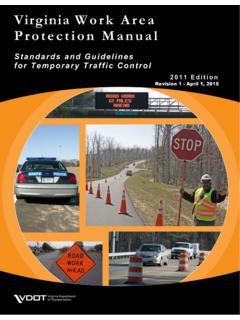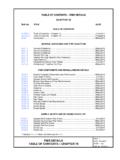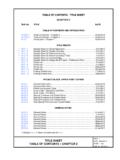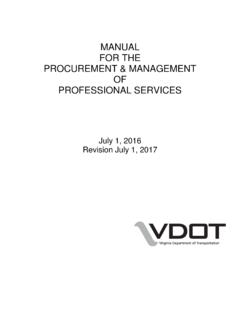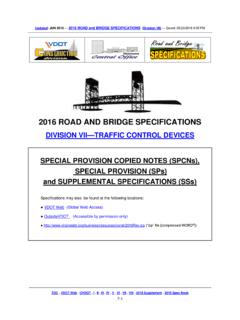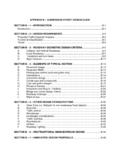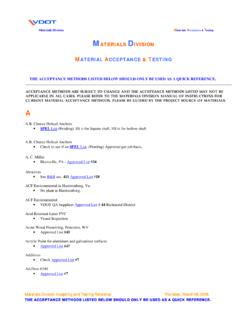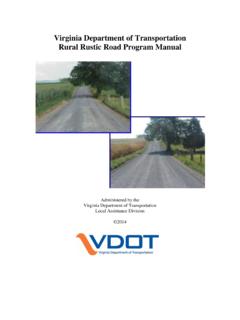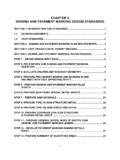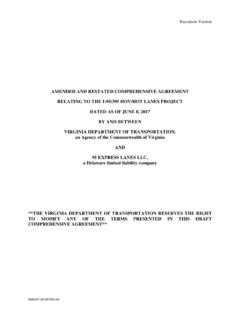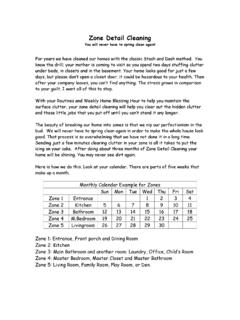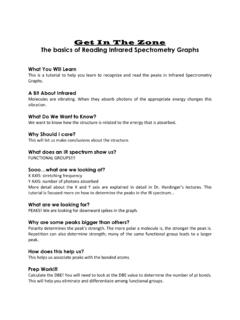Transcription of Work Zone Safety - Virginia Department of …
1 work Zone SafetyJanuary 2012 Guidelines forTemporary Traffic Control1 Table of ContentsIntroduction 3 Traffic Control Devices 4 Signs 4 Channelizing Devices 7 Lighting Devices 11 Component Parts of a Temporary Traffic Control Zone 13 Taper Length Criteria for work zones 15 work Zone Application in Curves and Hills 17 Shadow Vehicles 18 Truck Mounted Attenuators 19 Installing/Removing Lane Closures 19 Installing Lane Closure 20 Removing Lane Closure 21 Definitions 22 Typical Application Diagrams 24 work Outside the Shoulder 25 Permitted Temporary Entrance 27 Shoulder work Mobile or Short Duration Operation 29 Shoulder work Stationary Operation 31 Shoulder work with Minor Encroachment Stationary Operation 33 Four-lane Road Mobile Operation 35 Four-lane Non Limited Access Short Duration Operation 37 Four-lane Stationary Right Lane Closure 39 Four-lane Road Stationary Left Lane Closure 41 Center Turn Lane Closure on a Three-lane, Two-way Road 432 Table of Contents Lane Shift on a Three-lane.
2 Two-way Road 45 Two-lane Road Mobile Operation 47 Two-lane Road Mowing With Encroachment 49 Two-lane Road Stationary Closure 51 Automatic Flagger Assistance Device - Stop/Slow 53 Red/Yellow Lens 55 Two-Lane Roadway Temporary Disruption 57 Multi-Lane Roadway Temporary Disruption 59 Turn Lane Stationary Closure 61 Lane Closure in Advance of Intersection 63 Lane Closure Beyond Intersection Stop Signs on East/West Approaches 65 Stop Signs on North/South Approaches 67 Closure in Center of Intersection 69 Partial Ramp Closure Operation 71 Surveying Operations 73 Flagging Procedures 75 Liability 78 Daily Checklist for Temporary Traffic Control 79 Notes 803 IntroductionThe purpose of this handbook is to present basic guidelines for work zone traffic control and to supplement the 2011 Virginia work Area Protection Manual.
3 This handbook presents the requirements of Part VI of the Manual on Uniform Traffic Control Devices (MUTCD) with particular emphasis on short term work sites on roads and streets in rural and urban areas. These requirements apply to temporary traffic control zones , as found in construction, maintenance, and utility work areas. This handbook presents information and gives examples of typical traffic control applications for two-lane and multilane work zones . This information is intended to illustrate the principles of proper work zone traffic control, but is not a standard. The Virginia work Area Protection Manual contains the standards for temporary traffic control zones for roadways in Virginia and can be accessed at , Business Control Devices The following are four types of traffic control devices commonly used in work zone traffic control: u Signs uChannelizing Devices u Lighting Devices u Truck Mounted AttenuatorsSignsSigns used in work zone traffic control are classified as regulatory, guide, or warning.
4 Regulatory signs impose legal restrictions and may not be used without permission. Guide signs commonly show destinations, directions, and distances. Warning signs give notice of conditions that are potentially hazardous to SignsConstruction and maintenance warning signs are used extensively in street and highway work zones . These signs are normally diamond shaped, having a black symbol or message on an orange background. As a general rule, these signs are located on the right-hand side of the street or highway. On divided roadways with a median of 8' or greater, both left and right sides shall be signed. Smaller sign sizes may be used in the median when the median width is between feet and 8 feet to provide left sign assemblies on a multilane roadway.
5 SizeThe standard size for advance warning signs in work zones is generally 48" by 48". Where Right of Way or geometric conditions preclude use of 48" by 48" signs, 36" by 36" signs may be for height and lateral clearance of post mounted roadside signs are included in the Virginia work Area Protection Manual. Signs mounted on temporary supports may be at lower heights but the bottom of the sign shall not be less than one foot above the pavement SignsSheeting RequirementWarning signs shall be fluorescent prismatic lens sheeting for daytime or nighttime use. Roll-up type material signs, or an approved composite type sign, may be used on portable sign supports for up to three (3) consecutive days (72 hours).
6 Mesh signs are not of SignsSigns should be spaced as follows:Spacing of Advance Warning SignsUrban Street with 25 mph or less posted ' - 200'Urban Streets with 30 to 40 mph posted speed ' - 350'*All Other Roadways with 45 mph or less posted speed ' - 500'All Other Roadways with greater than 45 mph posted speed ' - 800'Limited Access Highways1300' - 1500'*Urban streets with greater than 40 mph posted speed limits fall into this of SignsTo retain the validity and respect of advance warning signs, when operations have ceased or conditions have changed such that the warning signs are no longer warranted, the signs and portable sign supports shall be removed from the DevicesCones36" " MINIMUM Drum 36"6"36" MarkerGROUP 1 Notes:1.
7 Flashing or steady burn warning lights and signs, when used, shall be NCHRP 350 or MASH com-pliant with the type of device it is mounted "45o6"6"24" " Panel12" 224"36"36"12"12"6"45oDirectional IndicatorLongitudinal ChannelizingDevice8 Channelizing DevicesNotes:1. Six inch wide stripes on barricade rails slope downward at an angle of 45 degrees in the direction traffic is to Type 3 barricades shall be NCHRP 350 or MASH Ballast shall not be placed on top of any striped to 12 in45o5 ft ft 3 BARRICADEPass to the Left6"9 Channelizing Devices (continued)Channelizing devices are used to warn and alert drivers of hazards in work zones , to protect workers, and safely guide and direct drivers past the hazards.
8 Channelizing devices include cones, tubular markers, drums, vertical panels, temporary raised islands, directional indicators, and longitudinal channelizing devices. The most common channelizing device used in short term work sites is the traffic ConesTraffic cones shall be orange in color and a minimum of 36 inches in height. Cones used at night shall be retroreflectorized by a 6 inch band and a 4 inch band space 2 inches a part. Cones greater than 36" in height shall have four alternating orange and white retroreflective stripes respectively 4" to 6" PanelsVertical panels shall be 12 inches in width and at least 24 inches in height. They shall have 6 inch orange and white diagonal stripes and shall be retroreflectorized.
9 Vertical panels shall be mounted with the top a minimum of 36 inches above the Indicators and Longitudinal Channelizing DevicesDirectional indicators and longitudinal channelizing devices shall comply with the descriptions on Page 7. Directional indicators shall only be used in tapers. Longitudinal channelizing devices shall interlock and may be used in place of cones or DevicesSpacingChannelizing devices should be spaced so that they make it apparent that the roadway or work area is closed to traffic. To accomplish this, the devices should be spaced based on the posted speed and by the following guidelines:Channelizing Device SpacingWork Zone LocationPosted Speed LimitSpacingIn Tapers and Curves35 mph or less20'Parallel to the Travelway35 mph or less40'Spot Construction Access*35 mph or less80'In Tapers and CurvesGreater than 35 mph40'Parallel to the TravelwayGreater than 35 mph80'Spot Construction Access*Greater than 35 mph120'* For easier access by construction vehicles into the work area, spacings may be increased to this distance, but shall not exceed one access per quarter drums must be a minimum of 36 inches in height and at least 18 inches in diameter with alternating orange and white retroreflective stripes 6 inches wide.
10 Each drum shall have a minimum of two orange and white stripes, and the top stripe shall be orange. Spacing of drums shall be the same as for cones. To ensure that the work zone is properly protected, drums shall be used to delineate unmanned work DevicesLighting devices for short term construction, maintenance, and utility work zones are designed to supplement the signs and channelizing devices used in these zones . Typical lighting devices include warning lights, vehicle lights, and flashing arrow LightsThe principal types and use of warning lights are: 1. Low Intensity Flashing Lights (Type A) used to warn of an isolated hazard at night. 2. High Intensity Flashing Lights (Type B)normally mounted on advance warning signs to draw attention to a hazard both day and night.
